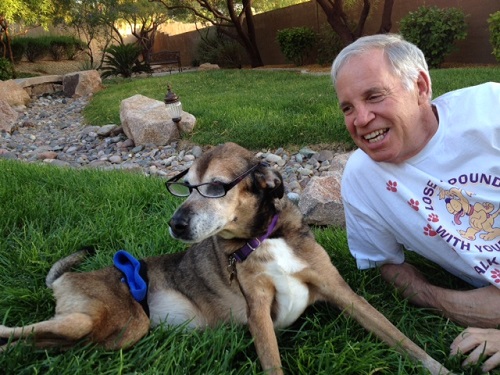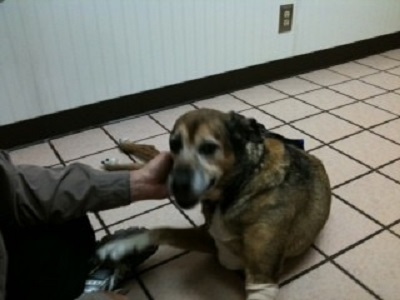
By Fall Sophie’s life and my life revolved around lots of medical tests. Each was designed to diagnose the cause of her progressive hind end weakness, but in our case, they only ruled out the conditions she didn’t have. They call that, diagnosis by elimination.
It was a frustrating time. No matter what we did, we weren’t getting any closer to finding the reason for her paralysis.
My home looked like a carpet showroom
While we tried to figure out Sophie’s problem, I realized we needed some practical solutions to keep her on her feet for as long as possible. That led to a trip to a carpet store to buy samples and remnants. I bought long strips of carpet and lined them throughout our tile hallways.
They kept Sophie from slipping when she walked. We had every shade in the rainbow of carpet strips all over the house.
I also pulled the pale green and brown carpet swatches our dogs loved to sit on while we watched TV. Those were scattered into every room. It was kind of tacky, but it worked.
Sophie liked lying down on the small pieces of carpet. They gave her traction when she got up off the floor. At this point she needed as much help as we could give because her back legs buckled under her, all the time.
Having the remnants everywhere helped in another way too. They were a “big, in our face” tangible reminder, that Ken and I were entering into new territory. I think it prepared us for what waited ahead.
The first round of tests
Our regular vet did the initial diagnostics. That was due to the fact that Las Vegas didn’t have a lot of veterinary specialists in 2008. She was very thorough and listened closely to our description of Sophie’s symptoms.
She ordered X-rays, blood work and manually manipulated Sophie’s legs and spine. It ruled out a lot of diseases.
The vet said she didn’t have: arthritis, hip dysplasia or a noticeable herniated disk. Sophie also didn’t show signs of an obvious spinal tumor or spinal stenosis. We even did a round of steroids to further rule this out. The idea was that if Sophie had a tumor or stenosis (narrowing of the spinal cord), we would see some improvement with anti-inflammatory steroids.
Sadly, the treatment didn’t make Sophie’s symptoms better or worse.
Next, we did exams that ruled out neurological conditions caused by ticks and fungal diseases that are common in the Southwest. Sophie was cleared from any of these problems.
A guess about Degenerative Myelopathy
Because Sophie didn’t have any pain and because her symptoms were getting worse, our vet decided to test for Canine Degenerative Myelopathy. DM is a heartbreaking, progressive disease of the spinal cord that leads to paralysis and eventual death.
It’s caused by a mutated gene that produces symptoms similar to Amyotrophic Lateral Sclerosis (ALS) in humans. DM strips away the myelin protective coating in the spine which insulates the nerves and allows the brain to communicate movement to a dog’s limbs.
DM starts with weakness in the hind legs and is generally seen in older dogs, like Sophie. German shepherds and shepherd mixes are prone. (You can read more about DM by clicking on the tab on our home page.)
Dogs with DM slowly become paralyzed in about six months from the onset of symptoms. The disease travels from the hind legs to the front and then into the respiratory system.
Sophie’s symptoms seemed to be following this course.
A misstep
Our vet suggested we do an at-home DNA test for DM. When the test arrived, I was supposed to swab Sophie’s cheek with a sterile Q-tip and wipe it on a specially treated card. The instructions said the card would turn purple.
The first swab didn’t turn purple, nor did the second. So, I kept repeating the test until I got a large purple smear to show up. I worried that I contaminated the test by re-swabbing Sophie’s cheek over and over, but I sent it to the lab anyway.
A week later the results came back negative for DM. I’ll never know if the results were accurate or if I contaminated the test. It still haunts me today.
An exam with a veterinary neurologist

The next step was a referral to veterinary neurologist for a more thorough exam and a possible MRI.
Sophie was scheduled for one of their first appointments of the day. While we waited in the lobby, I saw a brochure about financing diagnostic procedures. Our vet said testing would be expensive, but the brochure made me nervous.
To make matters worse, Sophie was extremely anxious that day. So, by the time we were taken to the exam room both of us were trembling.
A young female veterinarian came in and introduced herself. She tried to make friends with Sophie, but she wasn’t having any part of it. She read our report and started a brief exam. Then she said a more thorough exam would be done in the back of the office. She and Sophie walked off together.
I went back out to the lobby to wait. After the exam, the three of us met privately. The vet thought Sophie’s weakness involved both the front and rear sections of her spine. She suggested an MRI of her full spine.
I don’t remember the exact cost, but I do know it came as a shock to me. I also remember the vet saying an MRI couldn’t guarantee a diagnosis. She wanted it done to rule out illnesses like a spinal tumor and stenosis, problems our regular vet was pretty sure Sophie didn’t have.
We also discussed that a deep tumor was hard to remove and at 10-years-old, Sophie might not survive a complicated surgery like that.
It was a lot of information to absorb. The vet wanted to do the MRI that day, but I said I needed time to think.

Get the Essential Guide
The Essential Guide of Products for Handicapped Dogs e-book is a labor of love for me. I wrote it to answer your most pressing questions about where to find the best products for your wheelchair dog. You’ll find products you didn’t know existed and each will improve your dog’s quality of life. Print a copy and keep it by your side.
Mulling it over
On my way home, a flood of memories came back about the day Missy, our Lab, died. It was after having a diagnostic test to confirm a problem. Missy started to have trouble breathing that afternoon. Even her lips began to turn blue, so we rushed her to the vet. He suspected she had a paralyzed larynx, something she could have lived with if we kept her life calm and modified the size of her food.
The vet wanted to run a test to confirm his diagnosis, so he carried her to the back of the clinic. During the procedure something went wrong. Thirty minutes later, our baby girl was brain dead. We pulled the plug on her breathing tubes the next morning.
Now, a veterinarian who I’d never met before, wanted my okay to anesthetize my 10-year-old, weak and nearly paralyzed dog for an expensive test that only had a slight chance of determining a diagnosis.
I called the neurologist and told her we weren’t doing the MRI.
I didn’t realize it at the time, but my answer cut me off from further help from the neurology clinic. The MRI was the gateway to rehab services like physical therapy and water therapy.
At this point in time, I understand that without a proper diagnosis the vet didn’t know which rehab services could help Sophie. But at that moment it was a devastating blow.
It set Sophie up for a different treatment trajectory.
Second guessing myself
To this day I question my answer. All the “what ifs” rush to my brain. Maybe an MRI would’ve discovered the real cause Sophie’s paralysis. Maybe there would’ve been a surgery to cure her.
I’ll never know what might have been. And if you’re in this position now, trying to make life-changing decisions for your pet, please know that questioning yourself is part of the process. You’ll be offered information and you’ll do your best to make a decision based on your dog’s history, health and temperament. And unfortunately, you’ll also base it on financial resources.
Please know that whatever decision you make, I understand what you’re going through.





Leave a Reply